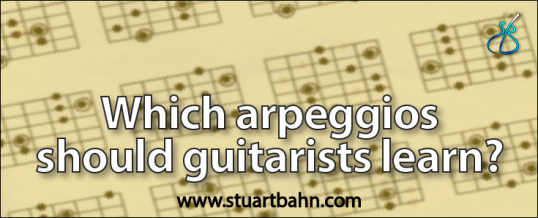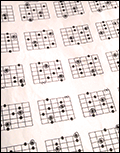
Arpeggios are the notes that make up a chord when played in succession, as oppose to at the same time.
They are just as valuable a resource for creating music as scales are, and in a way arpeggios are mini-scales of just three or four notes.
There are as many arpeggios as there are chords but in reality, we only need to learn a moderate number of them in order to meet most requirements.
So, which arpeggios should guitarists learn?
Triads
- Major and minor – these are essential arpeggios that are used at least some of the time in many styles of music, including pop, rock, blues, jazz and neoclassical.
- Diminished, augmented and sus chords – these should be viewed as optional by most guitarists. Whilst they have their uses, these arpeggios don’t appear very often in mainstream popular music.
Sevenths
- Dominant 7 – used frequently in jazz and fusion, and are an important ingredient in some blues and rock.
- Minor 7 – used frequently in jazz and fusion, and sometimes in other music; not least because it’s the same as the minor pentatonic scale without the 4th.
- Major 7 – used frequently in jazz and fusion, and occasionally in other melodic styles music.
- Minor 7b5 – used primarily in jazz and fusion.
- Diminished 7 – used primarily in jazz, fusion and neo-classical rock.
- Dominant 7sus4 – used primarily in fusion and in some jazz.
Is that it?
 For most guitarists, yes; unless you are into particularly esoteric music. Even this list may be more than necessary for many guitarists.
For most guitarists, yes; unless you are into particularly esoteric music. Even this list may be more than necessary for many guitarists.
You’ll find all of these arpeggios in the ‘Free stuff’ section of this website.
Each of these arpeggios can be used in a variety of ways. The most obvious approach, by far, is simply to play the arpeggio that corresponds to the chord you are playing over, eg: play an A7 arpeggio over an A7 chord.
More advanced arpeggio usage
There are more sophisticated approaches however, where the ‘wrong’ arpeggio is used over certain chords.
An example of this is an Em7 arpeggio played over an Am7 chord, which produces the equivalent of an Am9 arpeggio.
This is known as superimposing arpeggios and is the main reason why it’s not necessary to learn every individual arpeggio that exists. If you’ve never tried using an Em7 arpeggio over an Am7 chord before, why not try it now? It sounds great!
The possibilities of superimposition are limitless and require study once the essential arpeggios have been learned.
Which arpeggio shapes to learn?
As with scales, there are a variety of shapes to learn; five CAGED shapes for each, except the diminished 7th for which there is effectively just one shape.
You can also learn the three octave shapes that move diagonally across the neck.
These provide a greater range than the CAGED shapes do, and are particularly useful for certain phrases because of their repeating geometry.
Start learning arpeggios now
Arpeggios are as important as scales. If you don’t know or use many arpeggios yet, then make them a priority.
Start with the most common ones listed above and practise the shapes until you know them like the back of your hand.
Be sure to use them as a musical resource right away.
It takes a little effort to use new shapes of any kind but the more you do, the more familiar they will become and the better you will become as a guitarist.
Also see also article: “What scales should guitarists learn?”
If you liked this article ‘Which arpeggios should guitarists learn?’ please share it with others.
OCT
2013

About the Author:
Stuart Bahn is a professional guitarist and guitar educator in London, England.